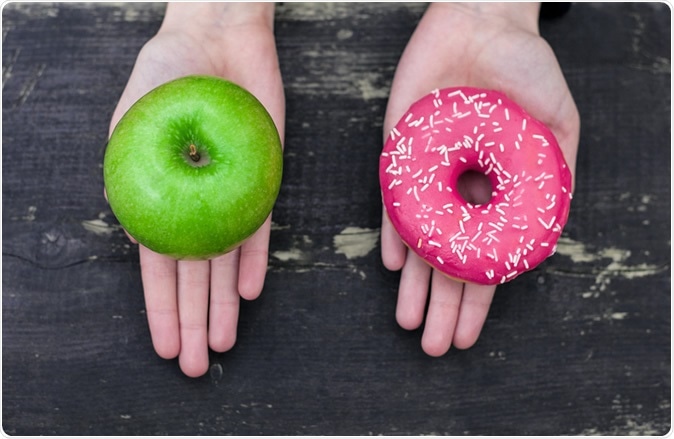Scientists across the globe have long studied the link between the brain and the digestive system. Previous studies have tied brain networks and how they influence the gastrointestinal tract or vice versa. Food has a unique effect on humans as food tastes or flavors often dictate food-seeking behaviors. So is the palate the only thing that controls food choices among humans?
There is more to just the mouth when it comes to eating and food choices. In fact, there are unique interactions between the digestive system and the central nervous system or the brain.
In a new study by researchers at the Neuropsychiatry Unit at the Champalimaud Centre for the Unknown, in Portugal, they identified a novel digestive-brain axis in mice. The study, which was published in the journal Neuron, sheds light on the importance of this connection and how it influences human behavior.

Study: Postingestive Modulation of Food Seeking Depends on Vagus-Mediated Dopamine Neuron Activity. Image Credit: Ana D / Shutterstock
Post-ingestive learning
The researchers described a phase that food goes through once it goes into the digestive tract – post-ingestive learning. They reiterated that when food enters the mouth, it decides whether the food is accepted or rejected. But, once inside the mouth, digestion starts, and the post-ingestive phase begins. The stage is characterized by the digestive system’s role of tasting the food, then relays information to the brain about meal choices.
There are two types of the post-ingestive process – the present and reactions in the future. The present deals with how nutritious the food is and how much should be consumed. Future responses deal with how the individual will respond to the same food when he or she consumes it again.
The team wanted to see if the same post-ingestive signals are involved in other learning types, specifically if they can make animals seek out certain foods actively. To arrive at their findings, the team developed a task wherein animals would press levers to receive a transfusion of food into the stomach.
“It was important to do it this way to eliminate the palatable aspects of the food and focus purely on its post-ingestive effects. In one experiment, we made two levers available to the mice: one that triggered the injection of high-calorie food and another that triggered the injection of low-calorie food. Then, we allowed them to choose freely between the two levers and observed their response,” Ana Fernandes, the study’s first author, said.
The team has found that even if the mice in the study were not able to taste the food, they strived to press the “high-calorie” lever. The team has unveiled a new post-ingestive learning type, but they proceeded to determine the physiological mechanism involved.
Gut feeling
The team focused on the vagus nerve, also called the X cranial nerve or 10th cranial nerve, which is the longest and most complex one and runs from the brain through the face, chest, and abdominal area. The nerve connects the brain to multiple organs, such as the heart, liver, and stomach.
Previous studies on the vagus nerve mostly concentrated on feeding behavior through the nerve’s connection to the gut. The current study focused more on a specific branch of the vagus nerve, which is thought to be more involved. The link is the one that carries information from the liver.
The team focused more on the liver, rather than the gut on post-ingestive learning. The team believes that the stomach may have incomplete data about the nutritional value of the food ingested. At the same time, the liver is responsible for metabolically filtering the blood coming from the gut. It means it has metabolic sensors for the food being eaten.
To prove their hypothesis, the team tried to lesion the hepatic branch of the vagus nerve, and the mice cannot acquire this new type of learning. The group said that the specific branch of the vagus nerve in the liver is the one that is responsible for sensing and relaying post-ingestive signals to the brain during the learning process.
The post-ingestive signals are sent to the brain, but where? The team suspected that the dopamine has something to do with these signals since it is a molecule responsible for various cognitive processes. Many studies in the past have shown a link between feeding and dopamine neurons in the brain. However, the connection between post-ingestive learning signals and dopamine has not been studied yet.
The researchers studied whether dopamine neurons were involved in post-ingestive learning. They were able to demonstrate that dopamine is included in the novel learning process. They also found that dopamine neurons were sensitive to post-ingestive signals, hence, making it essential for learning to happen.
“Dopamine neurons have been shown to respond to reward, for example, when a sweet treat reaches our tongue. This study shows that these neurons are also activated when foods reach the stomach and intestine. Furthermore, we showed that the activation of dopamine neurons when nutrients reach the gut is critical for driving food-seeking behaviors,” Rui Costa, also a senior author of the study, explained.
The team believes that the work provides a basis for how unique patterns of feeding behavior arise. The work is essential for understanding and treating eating-related disorders, such as obesity.
Journal reference:
Postingestive Modulation of Food Seeking Depends on Vagus-Mediated Dopamine Neuron Activity Fernandes, Ana B. et al. Neuron, https://doi.org/10.1016/j.neuron.2020.03.009